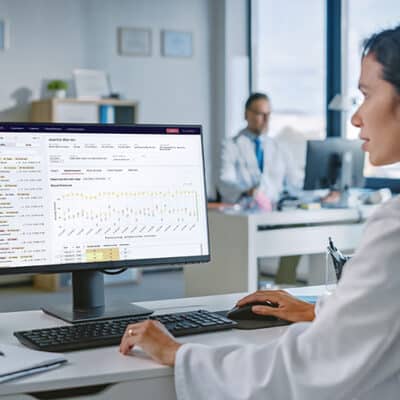In today’s rapidly evolving healthcare landscape, remote patient monitoring (RPM) has emerged as a leading healthcare delivery method that enables providers to deliver enhanced patient care outside traditional care settings.
For providers, RPM provides access to critical insights and patient health data that help them better manage chronic conditions and make more clinically informed decisions. RPM also increases efficiency, enhances patient-provider communication, and helps improve health outcomes. For patients, RPM can increase access to care, support improved self-management and provide a better patient experience while eliminating the logistical challenges of getting back and forth to doctor’s appointments.
For medical practices implementing an RPM program, one of the first and most critical steps is the effective integration into a practice’s electronic health records (EHR). Not only can a seamless integration help enable greater scalability and efficiency, but it can also help streamline workflows, reduce time spent on manual processes and paperwork, and lessen the administrative burden on providers and staff. The following are a few of the many benefits of EHR integration at 100Plus:
Benefits of EHR Integration at 100Plus
Streamlined Workflows
The seamless integration of an EHR into a remote patient monitoring solution helps reduce the need for manual data entry and lowers the risk of errors. As a result, clinics can optimize their workflows, saving valuable time and resources.
Simplified Billing
With 100Plus EHR integration, when eligible RPM claims for reimbursement are created, they can be automatically pushed into a practice’s EHR as a draft charge on a visit, saving time and simplifying the billing process.
Increased Scalability
EHR integration enables clinics to effortlessly scale their RPM programs to more patients by extending their reach to support broader patient populations without overwhelming clinical staff.
Access to Comprehensive Patient Health Data
One of the most significant advantages of EHR integration is the ability to quickly access comprehensive patient health information. With access to critical patient data, clinicians can make more informed decisions promptly, leading to quicker interventions and better patient outcomes.
Enhanced Care Coordination
EHR integration fosters seamless communication and collaboration among healthcare professionals involved in the patient’s care. By sharing patient health data, clinicians can work together to develop comprehensive care plans, ensuring continuity of care.
Improved Patient Engagement and Adherence
EHR integration plays a pivotal role in engaging and empowering patients in their own personal health journey. With access to their health information, they can more actively participate in their care decisions. This transparency fosters a sense of ownership and encourages patients to take charge of their health, leading to improved patient satisfaction and adherence to treatment plans.
The EHR Integration Process
At 100Plus, our industry-leading RPM solution securely integrates and exchanges healthcare data with all major EHRs, including AdvancedMD, Allscripts, AmazingCharts, Athena, Centricity, Cerner, Dr. Chrono, eClinicalWorks, Epic, Greenway, Intergy, NextGen, PracticeFusion and more.
Additionally, we use standard interfaces (FHIR, HL7, APIs), database connectivity, or web credentials, accurately mapping data to any required formats. Our engineers work with your team to validate connectivity and QA data to ensure everything runs smoothly.
How EHR Integration Works
5-minute setup for cloud-hosted EHRs:
- Access your EHR in your browser, copy the URL, and send it to us.
- Create a new user in your EHR to be used for the integration.
- For the new user, enable permissions to view patient’s vitals and visits, create charges, and documentation.
- Share the user account with 100Plus, then your practice will receive a notification from 100Plus once the integration is complete.
The integration of EHR into remote patient monitoring offers a multitude of benefits for both healthcare providers and patients. From enhanced efficiency and scalability to improved care coordination and patient engagement, the advantages are numerous.
Access the Latest RPM News
Stay up to date with the latest news, articles and webinars about remote patient monitoring and telehealth.
"*" indicates required fields
Start The Path Toward Better Patient Care
Have questions about how remote patient monitoring for healthcare will work for you and your patients? Let’s have a conversation.



